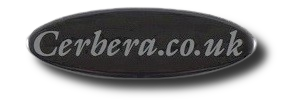I’ve raved about my close ratio gearbox in a couple of posts already, but never really explained why and the science behind it.
The close ratio gearbox (or gear kit to be precise) is a replacement set of gears designed by Gearboxman (Competition Transmission Services) and manufactured under licence by Quaife.
The size of each gear determines the ratio of drive, so by altering the gear sizes, you can change the the speed that each gear will produce at a certain RPM.
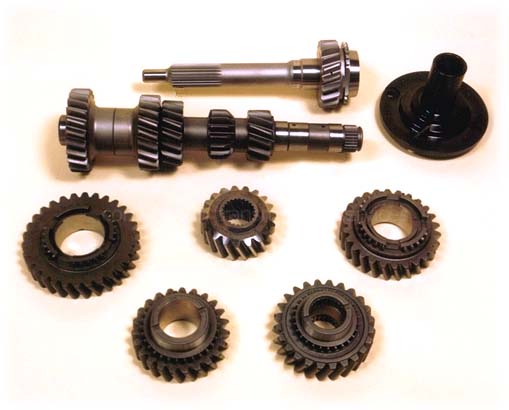
Gear Ratios
The table below shows the factory BorgWarner T5 gearbox (normal) ratios found in the TVR model range from the Griffith 500 to the Sagaris, and the Close Ratio gear-kit ratios.
| Ratios | |||||
| 1st Gear | 2nd Gear | 3rd Gear | 4th Gear | 5th Gear | |
| Normal Ratio | 2.950 : 1 | 1.950 : 1 | 1.340 : 1 | 1.000 : 1 | 0.800 : 1 |
| Close Ratio | 2.527 : 1 | 1.675 : 1 | 1.259 : 1 | 1.000 : 1 | 0.867 : 1 |
What does it mean? Well, close-ratio is a bit of a misnomer. Some are closer together (meaning more frequent and earlier gear changes), but some are also longer meaning you would be travelling faster at the same RPM.
It’s best described visually, but before we get into that let’s first talk about the power-band.
Power Band
Terminology:
Torque: Torque is responsible for making your car accelerate quickly.
Horsepower: Horsepower helps define your cars top speed.
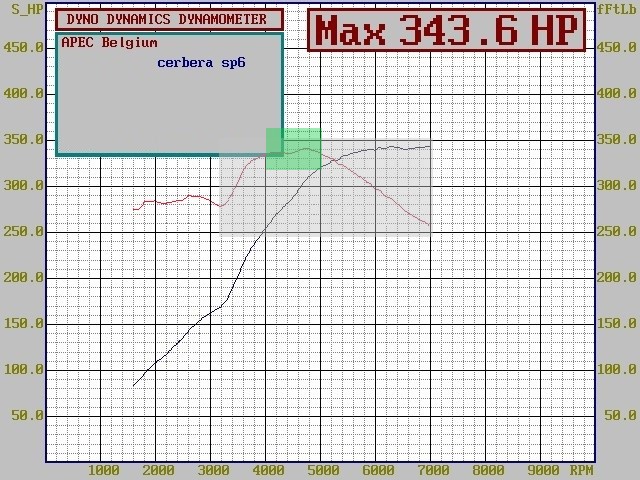
Power Band: A car’s power band is roughly defined as from when torque starts increasing rapidly to when horsepower begins to decline near the engines maximum operating speed. This range of rpms is where the engine preforms optimally and will accelerate the fastest.
On the dyno chart above, you can see the top line in red showing Torque, and the black line Horsepower.
The power band on a Cerbera is quite broad (shown in the grey box on the chart), it starts just after 3k RPM and runs all the way to red-line at 7k RPM.
But we live in the real-world, where every trip out in the Cerbera is not tearing down a drag-strip, red-lining every gear. For most of us, it is spirited drives with the occasional hard acceleration through a couple of gears; and in this common scenario, what’s important is making the most of that Power Band.
Making the most of the Power Band
Peak Torque (acceleration), occurs between 4-5k RPM (as highlighted in green on the dyno chart). The more time you can spend in that area, the more acceleration you have to play with during your spirited drive, and of course being nowhere near the red-line, it’s also mechanically sympathetic.
So how does a Close Ratio gearbox help you make the most of your power band?
How does a Close Ratio gearbox translate to driving experience?
Red line = factory ratio
Green line = close ratio
Green area = peak torque (as we saw on the dyno chart)
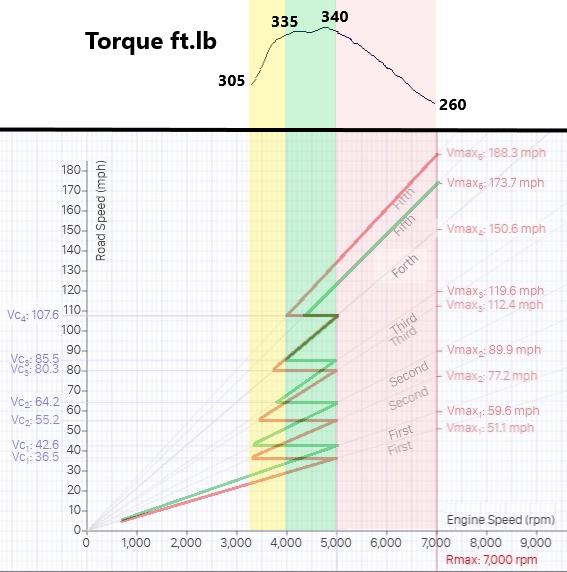
The zig-zag lines show RPM rising from A to the gear change B at 5k RPM (5k RPM because it’s peak torque and it’s sympathetic 😉 ), then on changing gear RPM dropping to the next A, and so on.
By comparing the Green to the Red, you can see that when gear ratios are closer together, the engine has less resistance, much like comparing shifting from 2nd to 4th, vs 2nd to 3rd. This is obvious I know, but what’s important is that the difference means you are kept in the upper range of the power band.
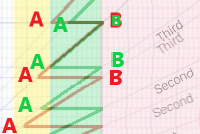
Note: The chart was produced by an online tool by simply entering the different gear ratios, diff ratio and tyre size. I am running a standard factory diff (3.46 : 1)
So what does it tell us?
We know the Cerbera is a Jekyll & Hyde car. Most of the time you want to be able to pootle around enjoying the burble of the exhaust tone, but sometimes you want a spirited drive. So ideally it needs to be the best at both.
- The 1st gear in the factory gearbox is only really good for manoeuvring i.e. parking – it’s too short. On the CR graph green line you can see that actually the 1st gear is longer. It’s 20% longer, i.e. at 3k RPM you will be at 26mph instead of 22mph. This may not sound like much, but believe me, it makes a huge difference when pootling along in traffic.
- Because you are in the right-hand side of the upper torque band, it means you pull harder in all gears.
- 5th gear being closer to 4th, is now used like another gear, not like an overdrive. Whereas before it was reserved for just cruising on the motorway, you’ll find yourself using it elsewhere.
So for me, it’s a win so far for the Close Ratio, it delivers for pootling around, and it delivers for spirited driving.
What are the downsides to a Close Ratio box?
The difference in ratios between 4th & 5th gear in the standard box is 20%. In the CR box it is 13%. It’s the being closer together that give you the benefit #3 above. The downside is that your RPM will be higher for motorway cruising. At 3k RPM with the factory box you will be doing 81 MPH, with the CR box it will be 74 MPH. Naturally, the overall top-speed is reduced too.
I’m sure you have heard what a straight-cut gear box sounds like, you hear them on rally cars. They whine very loudly. The benefit of straight cut gears is they reduce power loss through the transmission. The downside is they are bloody noisy! Not a problem for the RAC Rally, but not something you would want day-to-day. While there are some CR boxes that are straight cut, the Quaife one is what they call semi-helical (or semi straight cut). So can you hear it? If our cars were silenced like a new euro-box daily-driver, then yes for sure. But 95% of the time, the noise is drowned out by the exhaust. It’s only at low speeds pootling around that you might hear it, and then it just sounds like a mild super-charger.
Other benefits
The gears themselves are bigger and stronger.
The 5th gear now runs on needle rollers, eliminating the fragility of the 5th gear.
Conclusion
Having lived with the Close Ratio box for a few years now, I’m a huge fan as you can tell. What little downsides in my opinion are massively outweighed by the benefits.
In my opinion it really does it all. Pootling around is easier, having a blast is more fun, and on track being able to change down to 1st for a hairpin is an advantage.
During my research, I also was curious as to what the optimal RPM gear change would be if you did want to achieve max speed in the least time (i.e. a drag strip). Is it to change gear at maximum Horsepower (max RPM), or change at maximum Torque, or somewhere in between? The answer is to red-line every gear. Check out this tool for the science behind that, and thanks to Samir for your assistance.
These Quaife close ratio gear kits used to be widely available, but these days the manufacturing has slowed right down and the waiting list grown. Click here to read more (this link will take some time to load so be patient)
